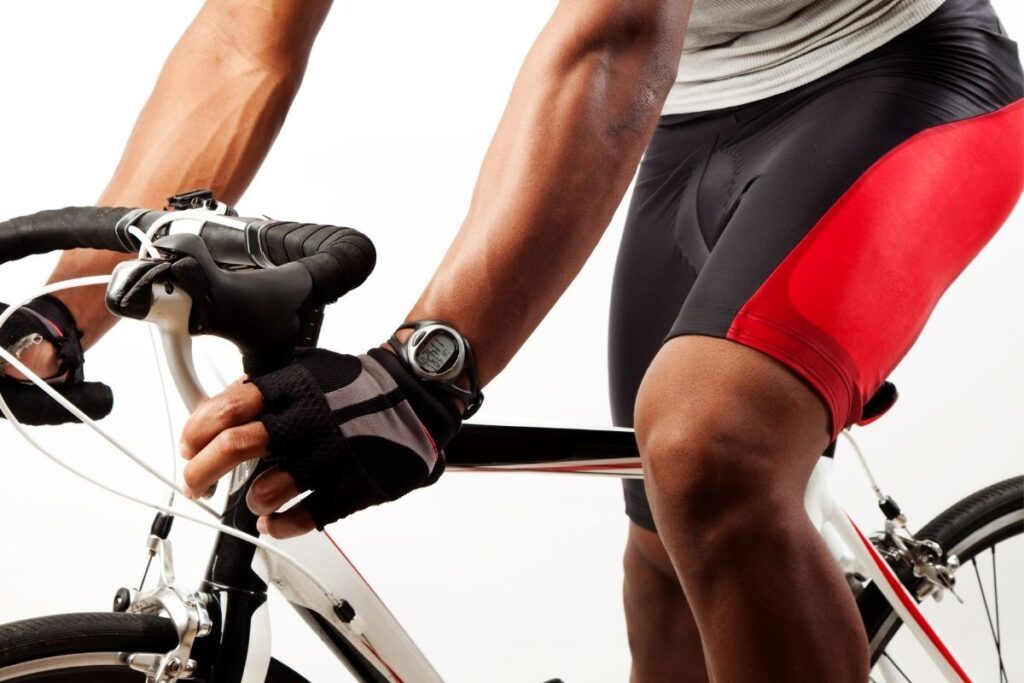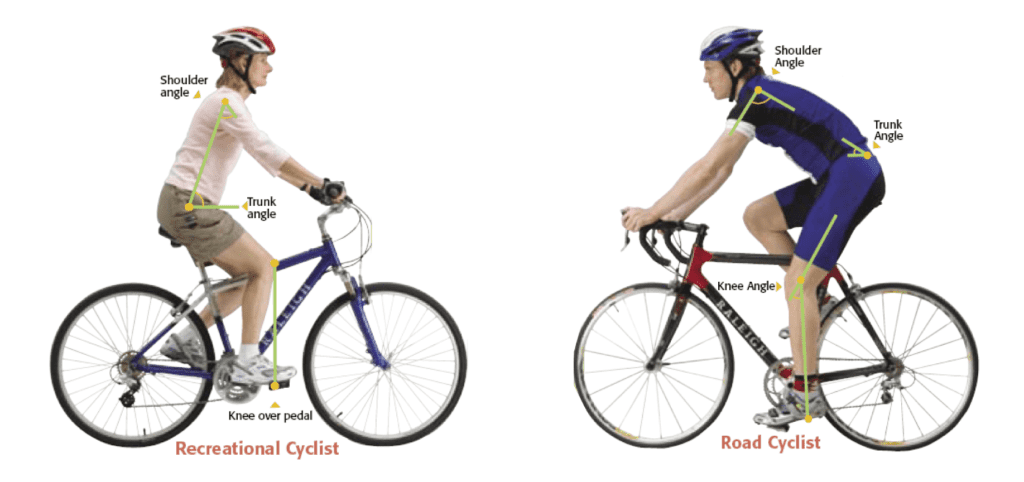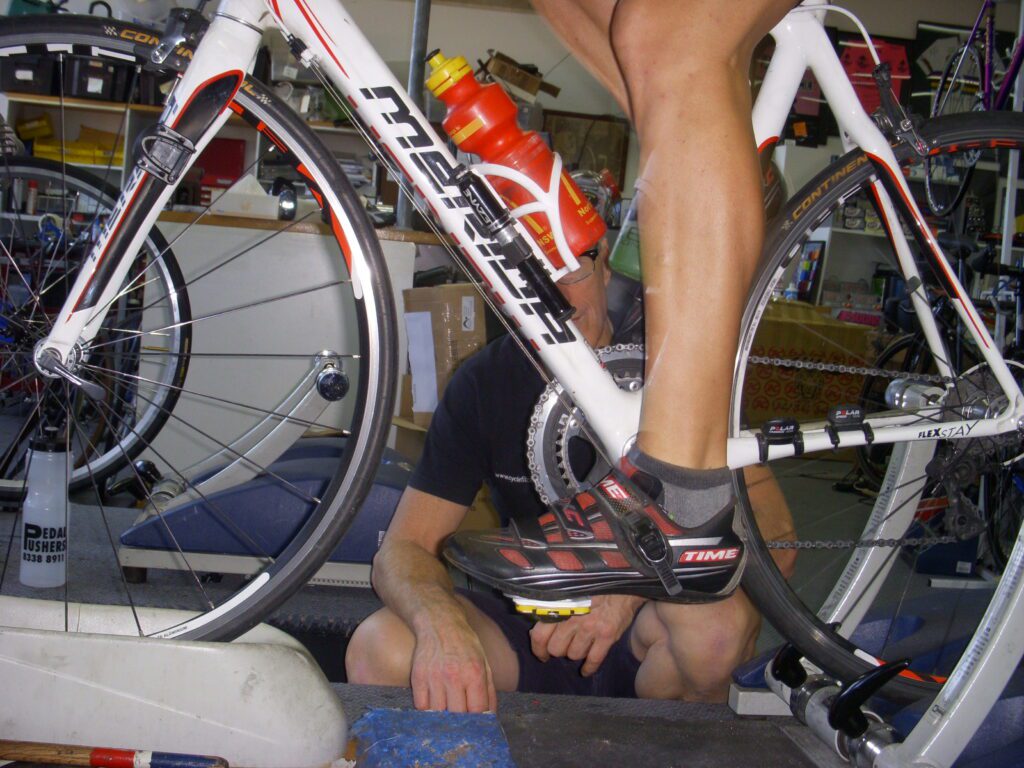


Is cycling harmful for knees? Cycling is generally considered a low-impact exercise that is gentle on the knees, but proper bike fit, technique, and caution are crucial to prevent knee strain or injuries.
Read More : ” Which Is Best Hybrid Or MTB Cycle? “
Cycling is generally considered a low-impact exercise that is not harmful to the knees for most people. In fact, cycling is often recommended as a knee-friendly exercise, especially for those with knee issues or joint pain.
The reason behind this is that cycling is a non-weight-bearing activity, meaning it doesn’t put excessive pressure on the knee joints compared to activities like running or jumping.
However, there are a few factors to consider to ensure that cycling remains safe for your knees. Proper bike fit is essential to avoid any undue stress on the knees.
Ensure that your saddle height and position are adjusted correctly to prevent hyperextension or excessive bending of the knees during pedaling.
Additionally, pedaling with a higher cadence (number of pedal revolutions per minute) and using lower gears can reduce strain on the knees.
It’s also essential to maintain good form and avoid pushing excessively hard on the pedals, especially during uphill climbs.
For some individuals with pre-existing knee conditions or improper bike fit, cycling may still cause discomfort or pain.
If you experience knee pain while cycling, it’s crucial to consult a healthcare professional or a bike fitting specialist to address any issues and ensure safe and enjoyable cycling.
Understanding the Impact of Cycling on Knee Health



Cycling is generally considered a low-impact exercise that is gentle on the knees, making it an excellent choice for people with knee issues or those looking for a joint-friendly workout.
Read More : ” Is It Hard To Ride A Mountain Bike On Road? “
The circular motion of pedaling allows for smooth movement, reducing the impact and stress on the knee joints compared to other high-impact activities like running.
Regular cycling can help improve joint flexibility, strengthen the surrounding muscles, and enhance the stability of the knee joint.
However, it’s essential to maintain proper bike fit and use correct pedaling techniques to minimize the risk of knee discomfort or injury.
Ensuring the saddle height, handlebar position, and pedal alignment are appropriate for your body can greatly contribute to knee health.
While cycling is generally knee-friendly, individuals with pre-existing knee conditions or injuries should approach cycling with caution and seek guidance from a healthcare professional.
Overuse, improper technique, or excessive strain on the knees can lead to issues, so it’s essential to listen to your body and adjust your cycling routine accordingly.
In conclusion, for the majority of people, cycling is a safe and effective exercise that is unlikely to harm the knees and can even provide numerous benefits for overall joint health.
However, it’s crucial to be mindful of proper bike fit and technique to ensure a positive and knee-friendly cycling experience.
Cycling and Knee Joints: The Low-Impact Advantage



Cycling and knee joints share a unique relationship where the wheels spin with grace, and the knees dance with delight. Unlike high-impact activities that can cause knees to groan, cycling glides along as a low-impact champion.
Read More : ” Fat Bike VS MTB “
With each pedal stroke, the knees find solace in the circular motion, avoiding the jarring impact of pounding feet on the ground.
Picture a symphony of joint-friendly movement, where the knee joint is the star conductor, leading the way to smooth, fluid motion. As the pedals turn, the knees sway with ease, basking in the gentle rhythm of cycling.
This low-impact advantage allows people with knee concerns to pedal their worries away and embrace the joy of staying active.
But the harmony doesn’t end there. Cycling’s benefits extend beyond just knee comfort. The circular motion enhances joint flexibility, unlocking the door to a world of improved range of motion.
Strong muscles chime in as supporting instruments, playing their part in protecting the knees and providing stability during the performance.
However, like any virtuoso, proper form is crucial. The saddle height and handlebar position must be orchestrated to fit one’s body, ensuring a perfect symphony of bike fit.
Smooth pedaling technique adds finesse to the act, reducing the risk of knee discomfort or injuries.
In conclusion, cycling and knee joints are like dance partners, moving together in sync to the rhythm of low-impact bliss. So, hop on your bike, let your knees take the lead, and savor the delightful melody of joint-friendly cycling.
Proper Bike Fit: Ensuring Knee-Friendly Cycling



Proper bike fit is the secret ingredient to a knee-friendly cycling experience, where the harmony of rider and machine is finely tuned.
Related : ” Is Biking Hard On Knees? “
Just like a tailor customizes a suit to fit perfectly, a bike fit specialist tailors the bike to match the unique dimensions and biomechanics of the rider.
Imagine the bike as a musical instrument, and the rider as the musician. To create a symphony of knee-friendly cycling, every element must be in tune.
The saddle height, fore-aft position, and handlebar reach are carefully adjusted to achieve optimal alignment and balance.
As the rider mounts the bike, it’s like striking the first chord. A bike fit expert listens intently to the rider’s feedback, making minute adjustments like tuning the strings of a guitar until it feels harmonious.
The knees, acting as the conductor of this orchestration, are given prime attention. The goal is to find the sweet spot where the knees move effortlessly, like a bow gliding across the strings of a violin.
But the melody doesn’t stop there. Proper bike fit enhances overall performance and efficiency. It maximizes power output, ensuring that each pedal stroke is strong and purposeful, much like a virtuoso showcasing their skills.
A well-fitted bike prevents unnecessary stress on the knees and helps prevent injuries. It’s like having a guardian angel that watches over the knees, protecting them from potential harm and ensuring a lifetime of cycling joy.
In conclusion, proper bike fit is the conductor that harmonizes the rider’s body with the bike, creating a symphony of knee-friendly cycling.
So, invest in a bike fit session, let the expert work their magic, and enjoy the smooth, knee-loving ride ahead.
Related: Is biking good for knee pain?
Pedaling Techniques: Reducing Stress on the Knees



Pedaling techniques play a vital role in reducing stress on the knees during cycling, akin to a graceful dance between the rider and their bike.
Read More : ” Why Are Mountain Bikes So Expensive? “
Imagine the knees as delicate ballerinas, and the pedals as their stage. With the right techniques, the performance becomes a seamless and effortless ballet.
To begin this graceful act, focus on maintaining a circular pedal stroke. Just like drawing perfect circles with a paintbrush, avoid placing excessive pressure on any particular part of the stroke.
Instead, aim for a smooth and fluid motion, distributing the effort evenly throughout the rotation.
Next, engage the core muscles, acting as the sturdy stage floor that supports the dancers. A stable core helps transfer power from the legs to the pedals without undue stress on the knees.
Imagine the core as a pillar of strength, keeping the body balanced and aligned.
Now, let’s add a touch of finesse with proper gear selection. Picture each gear as a different musical note, and the rider as a skilled composer.
Choose the appropriate gear to match the terrain and cadence, allowing the knees to move with ease and grace.
As with any dance, timing is essential. Coordinate the pedal strokes with the natural rhythm of the ride. Like a skilled choreographer, sync the knee movements with the bike’s motion, minimizing unnecessary stress and maintaining a symphony of fluidity.
Lastly, listen to your body as if it were a gifted conductor. If the knees hint at discomfort, adjust your techniques accordingly. Remember, this is a performance of joy, not endurance. So, don’t push beyond your limits.
In conclusion, pedaling techniques are the graceful ballet of cycling, where the knees and pedals dance in harmony. Master these techniques, and your knees will thank you with each exquisite pedal stroke.
Common Knee Issues in Cycling: Causes and Prevention



Knee issues in cycling can be likened to a delicate symphony, where every note has a role to play. But sometimes, even the finest performances face challenges.
Read More : “How To Clean A Mountain Bike? “
Let’s unravel the causes behind these knee issues and discover the secrets to prevention.
The Overture: Bike Fit
Just like a musical instrument, your bike needs to be in tune with your body. A proper bike fit ensures optimal alignment, reducing the risk of strain on the knees.
Imagine the bike fit as the opening notes, setting the stage for a harmonious ride.
Act I: Overuse
When one instrument plays too loudly, it disrupts the harmony. In cycling, overuse can lead to knee issues. Avoid pushing yourself too hard, especially when increasing mileage or intensity. Like a skilled conductor, balance your training and recovery.
Act II: Improper Pedaling Technique
Just as a pianist’s fingers glide effortlessly across the keys, your feet should pedal smoothly. Be mindful of maintaining a circular pedal stroke, distributing pressure evenly, preventing unnecessary strain on the knees.
Act III: Gear Selection
Imagine gear shifting as a skilled composer. Choose gears that complement your cadence and terrain, preventing excessive pressure on the knees. An exquisite choice of gears ensures a symphony of motion.
Finale: Warm-up and Cool-down
Every performance requires preparation and closure. Warm-up before your ride to loosen up your knees, and cool down afterward to gently bring the performance to an end. Proper warm-ups and cool-downs keep knee issues at bay.
In this grand symphony of cycling, understanding the causes behind knee issues allows us to take proactive measures.
By addressing these concerns, you become the maestro of your cycling journey, conducting a breathtaking performance without a single discordant note.
Safety Precautions: Listening to Your Body and Seeking Professional Advice



Safety precautions in cycling are akin to a conductor carefully orchestrating a masterpiece. When we listen to our body’s cues and seek professional advice.
we ensure a harmonious and safe journey on two wheels.
The Prelude: Listen to Your Body
Just like a musician tunes their instrument, cyclists must attune themselves to their bodies. Pay attention to any discomfort or pain, as it may be a signal of potential issues. Acknowledge these notes and take appropriate action.
Movement Allegro: Proper Form and Technique
A virtuoso cyclist knows the importance of proper form and technique. Maintain a balanced posture, engage your core, and position your hands on the handlebars with grace. By doing so, you create a solid foundation for a melodious ride.
Crescendo of Safety Gear: Donning the Helmet
Every masterpiece needs a strong foundation, and for cyclists, it’s the helmet. As a conductor protects their head with a baton, cyclists safeguard their brain with a helmet, ensuring safety during their performance on the road.
Fortissimo of Awareness: Road Vigilance
Like a conductor anticipating every beat, cyclists must be vigilant on the road. Be aware of your surroundings, road conditions, and traffic, allowing you to navigate with confidence and prevent accidents.
Safety Cadence: Lights and Reflective Gear
As a symphony conductor guides the musicians with gestures, cyclists guide others with lights and reflective gear. Illuminate your presence on the road, especially during low-light conditions, to enhance visibility.
The Finale: Professional Expertise
Even maestros seek advice from fellow musicians. Similarly, cyclists should consult with professionals for proper bike maintenance, adjustments, and any health concerns related to cycling.
By embracing these safety precautions, cyclists conduct a harmonious symphony of safety and enjoyment.
Like a well-rehearsed orchestra, they navigate the roads with confidence, ensuring every note of their cycling journey is composed with care and diligence.
Enjoying Knee-Friendly Cycling for a Healthy Active Lifestyle



Embracing knee-friendly cycling is like dancing with the wind, gracefully flowing through life’s rhythm with every pedal stroke.
Let’s pirouette into the world of knee-friendly cycling, where movement becomes a harmonious symphony of health and joy.
Bike Fit
Just like a dancer’s posture sets the stage for a flawless performance, proper bike fit is crucial for knee-friendly cycling.
Adjust the seat height and handlebars to ensure optimal alignment, reducing stress on the knees and inviting a seamless pas de deux with your bike.
Gear Selection
Cycling is an art of efficiency, and choosing the right gear is akin to selecting the perfect dance move. Shift gears smoothly, matching the effort with the terrain, and sparing your knees from unnecessary strain.
Pre-ride Stretching
As a dancer warms up their body before a performance, cyclists should indulge in pre-ride stretching. Limber up your muscles, enhancing flexibility, and preparing your knees for a stunning performance on the saddle.
Steady RPM
Just as a ballet dancer maintains an even tempo, cyclists should aim for a steady cadence. Pedal at a comfortable RPM (revolutions per minute), avoiding sudden bursts of effort that might overexert your knees.
Hydration and Nourishment
Proper nutrition fuels a dancer’s body, and the same applies to cyclists. Stay hydrated and nourished during your ride, supporting your knees and maintaining your energy for a mesmerizing experience.
Post-Ride Rest
After an enchanting performance, dancers recover with rest and care. Likewise, cyclists should prioritize post-ride recovery, allowing their knees to rejuvenate and restore for future captivating rides.
By savoring knee-friendly cycling as a captivating dance with life, cyclists embrace a healthy and active lifestyle. The rhythm of their pedals and the freedom of the open road blend into an enchanting waltz, making every ride a celebration of joy and well-being.
Explained With The Help Of A Table
| Factors | Impact on Knees | Mitigation |
| Proper Bike Fit | Ensures proper alignment and reduces stress | Get a professional bike fit to optimize posture |
| Gear Selection | Wrong gears strain knees | Choose appropriate gears for terrain and effort |
| Cadence | High cadence reduces knee strain | Aim for a steady RPM to prevent overexertion |
| Bike Type | Road and hybrid bikes have lower impact | Consider using road or hybrid bikes for gentler ride |
| Body Position | Improper posture can strain knees | Maintain a neutral spine and distribute weight |
| Pre-ride Warm-up | Skipping warm-up increases risk of injury | Stretch and warm up muscles before cycling |
| Terrain | Rough and hilly terrain can stress knees | Choose smooth and flat surfaces for lower impact |
| Recovery | Insufficient rest hinders knee healing | Allow ample rest and recovery after intense rides |
| Nutrition | Poor diet may not provide essential nutrients | Maintain a balanced diet to support knee health |
| Cross-training | Engage in strength training and flexibility | Strengthen muscles around knees and improve mobility |
Cycling, when done with proper technique, bike fit, and attention to terrain, can be a low-impact and knee-friendly exercise. However, certain factors can contribute to knee strain or injury.
By considering the factors in the table and adopting knee-friendly practices, cyclists can enjoy the benefits of cycling while minimizing the risk of knee-related issues.
Remember to listen to your body, seek professional advice if needed, and take necessary precautions for a safe and enjoyable cycling experience.
Cycles That Are Harmful For Knees
Here are some cycle types that are generally considered more stressful on the knees:
- Fixed Gear Bikes
- High-Intensity Road Bikes
- Mountain Bikes on Rough Terrain
- Spin Bikes with Heavy Resistance
- Improperly Fitted Bicycles
Conclusion
In conclusion, cycling is generally considered a low-impact exercise that is beneficial for knee health. However, certain factors like improper bike fit, excessive intensity, or riding on rough terrains can potentially lead to knee issues.
It is crucial to ensure proper bike fit, use appropriate gear, and listen to your body to enjoy knee-friendly cycling for a healthy and active lifestyle.
If you experience persistent knee pain or discomfort, seeking professional advice is recommended to address any potential issues early on and prevent further complications.
Remember, with the right precautions and responsible cycling practices, cycling can be a safe and enjoyable activity for people of all ages and fitness levels.
FAQ’s
Can cycling damage your knees?
Cycling is generally considered a low-impact exercise and is unlikely to cause knee damage when done with proper form and bike fit.
How do I protect my knees when cycling?
To protect your knees while cycling, ensure proper bike fit, maintain a comfortable saddle height, pedal with a smooth motion, use lower gears on inclines, and consider using knee braces if needed.
Which cycle is good for knees?
A well-fitted hybrid or road bike with a more upright riding position is generally considered good for knees, as it reduces stress on the joints compared to aggressive mountain biking.
What are the side effects of cycling?
Potential side effects of cycling include knee pain, back pain, and hand numbness. Overtraining and poor bike fit can exacerbate issues. Proper conditioning and equipment can mitigate risks.
Is cycling heavy on knees?
Cycling is generally low-impact and considered easy on the knees. However, improper bike fit, overtraining, or pre-existing knee conditions may cause discomfort. Proper technique and equipment are essential.



Welcome to Bikegenics, where passion meets performance! We are a leading online destination for all things related to mountain biking, dedicated to providing you with top-notch gear, expert advice, and an immersive community to fuel your two-wheeled adventures. With a commitment to excellence and a deep love for the sport, we strive to elevate your biking experience to new heights.
